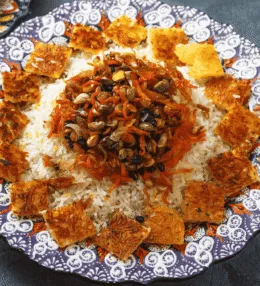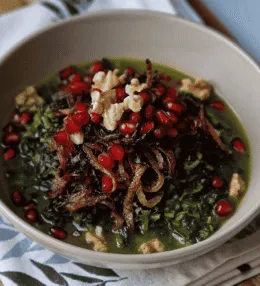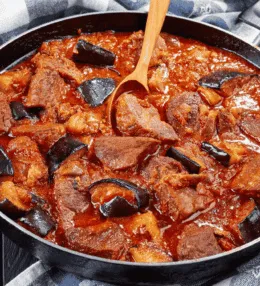
- View
Table of Contents
ToggleKuih Seri Muka is one of those desserts that feels both familiar and extraordinary at once. Popular throughout Malaysia, especially within Malay and Peranakan communities, it’s a two layered treat that plays with texture, colour and flavour in the most charming way.
Often found at traditional markets or made for festive gatherings and tea time, it stands out for its striking green custard top and glutinous rice base. While it’s undeniably sweet, it also carries earthy, creamy and slightly savoury undertones that make it far more complex than it first appears.
Want to dive deeper into Malaysian Cuisine? Don’t miss our post on 27 Traditional Malaysian Foods to Try
What Is Kuih Seri Muka?
Kuih Seri Muka is a steamed Malaysian dessert made up of two distinct layers. The bottom is made from sticky glutinous rice, slightly salted and sometimes infused with coconut milk, which gives it a dense yet tender chew.
The top layer is where the eye is immediately drawn, a vibrant green custard made with pandan juice and coconut milk, firm but creamy, and full of that unmistakable floral aroma.
This dessert is typically cut into neat squares or diamonds and served at room temperature. Though it looks delicate, it holds its form well and is often eaten by hand. It’s a fixture in many Malaysian kuih platters, sitting comfortably alongside other local favourites.
What sets Kuih Seri Muka apart is its careful balance of richness and fragrance, the pandan layer soft and custardy, the rice layer warm and grounded.
Ingredients and Taste
The top layer gets its colour and scent from pandan leaves, which are blended with water to extract their bright green juice. This is mixed with eggs, sugar and coconut milk, creating a custard that’s steamed gently until it sets. It’s creamy without being too soft and carries a light sweetness with herbal, grassy notes that come through with each bite.
The bottom layer, made from glutinous rice, offers a pleasant contrast. Cooked with a pinch of salt and sometimes soaked in coconut milk, it adds a slightly savoury edge that plays beautifully against the sweetness of the custard.
Together, the layers offer a harmony of flavour and mouthfeel, the top smooth and luscious, the bottom satisfyingly sticky. It’s not overly sweet, which makes it easy to reach for a second piece, and the richness is balanced by the freshness of pandan and the gentle salt in the rice.
A Taste of History
Kuih Seri Muka is deeply rooted in Malay culinary tradition, though its exact origins are hard to pinpoint. It reflects the cultural layers of Malaysia itself, blending local ingredients and techniques with influences from both the Malay and Peranakan kitchens.
The use of pandan and coconut milk is a hallmark of Southeast Asian sweets, while the glutinous rice base ties it to wider regional rice traditions found across Indonesia, Thailand and beyond.
Often prepared during festive seasons like Hari Raya or served at weddings and communal celebrations, Kuih Seri Muka is as much about ritual and memory as it is about taste.
It’s passed down in handwritten recipes, learned in kitchens with no measuring cups, just instinct and practice. That enduring connection to heritage is what gives it its depth, a dessert that tells a story with every bite.
How To Make Kuih Seri Muka
Ingredients
For the Bottom Glutinous Rice Layer:
- 200g glutinous rice (soaked for at least 4 hours or overnight)
- 150ml thick coconut milk
- ½ tsp salt
- 1 pandan leaf, knotted (optional but traditional)
For the Top Pandan Custard Layer:
- 2 large eggs
- 100g caster sugar
- 150ml thick coconut milk
- 60ml pandan juice (from blending pandan leaves with a bit of water and straining)
- 30g plain flour
- 15g rice flour
- ⅛ tsp salt
Instructions
Step 1/9
To begin, grease an 18cm square tin and line the bottom with banana leaf or parchment paper. Drain the soaked glutinous rice and place it in a heatproof bowl or the lined tin. Add the coconut milk, salt, and pandan leaf. Steam over medium heat for 25 minutes, or until the rice is tender but not mushy.
Step 2/9
Remove the steamed rice, discard the pandan leaf, and fluff with a fork. While hot, press the rice firmly into the tin using a spatula or the back of a spoon to form an even, compact layer. This helps the custard adhere properly later.
Step 3/9
While the rice cools slightly, prepare the pandan layer. In a mixing bowl, whisk together the eggs and sugar until the mixture is smooth and the sugar has mostly dissolved, avoid overbeating to prevent bubbles in the custard.
Step 4/9
Stir in the coconut milk and pandan juice. Mix well to combine, ensuring a uniform green colour. Then, sift in the plain flour and rice flour gradually while whisking continuously to avoid lumps. Add the salt and mix until the batter is silky.
Step 5/9
Strain the pandan custard through a fine sieve to remove any clumps and ensure a smooth finish. This step is key for achieving a glossy, even custard surface.
Step 6/9
Place the tin with the pressed rice layer back into the steamer. Gently pour the pandan custard over the rice using a ladle or back of a spoon to soften the pour, this prevents disturbing the rice layer.
Step 7/9
Cover the steamer lid with a tea towel (to catch condensation) and steam on low heat for 30–35 minutes, or until the custard sets completely. The surface should feel firm to the touch and not wobble.
Step 8/9
Once done, turn off the heat and allow the kuih to cool fully in the tin. Avoid cutting while warm, as the custard needs time to set completely for clean slices.
Final Step/9
Once cooled, remove the kuih from the tin and cut into small squares or diamond shapes using a lightly oiled knife. Serve at room temperature. Kuih Seri Muka pairs beautifully with unsweetened jasmine tea or strong kopi for contrast.
Cooking Tips for Perfect Kuih Seri Muka
- Use Thai glutinous rice for the best chewy texture and aroma.
- Avoid high heat when steaming the custard, a gentle simmer prevents bubbling or cracking on the surface.
- Strain the pandan layer to remove bubbles and lumps for a silky custard top.
- Compact the rice well, a loosely packed base may cause the layers to separate during slicing.
- Use natural pandan juice for authentic fragrance and a vibrant green hue, avoid artificial colouring if possible.

Kuih Seri Muka (Two Layered Dessert)
Equipment
- Steamer with lid
- 18cm square tin
- Banana leaf or parchment paper
- Mixing bowls
- Fine sieve or strainer
- Whisk
- Spatula or spoon
- Tea towel or muslin cloth
- Knife (lightly oiled)
Ingredients
For the Bottom Glutinous Rice Layer:
- 200 g glutinous rice soaked for at least 4 hours or overnight
- 150 ml thick coconut milk
- ½ tsp salt
- 1 pandan leaf knotted (optional but traditional)
For the Top Pandan Custard Layer:
- 2 large eggs
- 100 g caster sugar
- 150 ml thick coconut milk
- 60 ml pandan juice from blending pandan leaves with a bit of water and straining
- 30 g plain flour
- 15 g rice flour
- ⅛ tsp salt
Instructions
- To begin, grease an 18cm square tin and line the bottom with banana leaf or parchment paper. Drain the soaked glutinous rice and place it in a heatproof bowl or the lined tin. Add the coconut milk, salt, and pandan leaf. Steam over medium heat for 25 minutes, or until the rice is tender but not mushy.
- Remove the steamed rice, discard the pandan leaf, and fluff with a fork. While hot, press the rice firmly into the tin using a spatula or the back of a spoon to form an even, compact layer. This helps the custard adhere properly later.
- While the rice cools slightly, prepare the pandan layer. In a mixing bowl, whisk together the eggs and sugar until the mixture is smooth and the sugar has mostly dissolved, avoid overbeating to prevent bubbles in the custard.
- Stir in the coconut milk and pandan juice. Mix well to combine, ensuring a uniform green colour. Then, sift in the plain flour and rice flour gradually while whisking continuously to avoid lumps. Add the salt and mix until the batter is silky.
- Strain the pandan custard through a fine sieve to remove any clumps and ensure a smooth finish. This step is key for achieving a glossy, even custard surface.
- Place the tin with the pressed rice layer back into the steamer. Gently pour the pandan custard over the rice using a ladle or back of a spoon to soften the pour, this prevents disturbing the rice layer.
- Cover the steamer lid with a tea towel (to catch condensation) and steam on low heat for 30–35 minutes, or until the custard sets completely. The surface should feel firm to the touch and not wobble.
- Once done, turn off the heat and allow the kuih to cool fully in the tin. Avoid cutting while warm, as the custard needs time to set completely for clean slices.
- Once cooled, remove the kuih from the tin and cut into small squares or diamond shapes using a lightly oiled knife. Serve at room temperature. Kuih Seri Muka pairs beautifully with unsweetened jasmine tea or strong kopi for contrast.
Nutrition
You May Also Like






